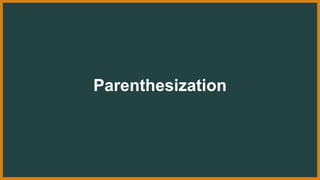
Parenthesization.pptx
- 2. CONTENTS 01 Problem statement Explaining of the problem 02 Design Approach Implementation method 03 Code Java code for the same 05 Conclusion Conclusion 04 Analysis Analysing the code.
- 4. Design Approach 02 • This approach uses recursion and backtracking to find all possible paranthesizations of a given string of symbols from a given set of characters. • The function isSymbolPossible() tries to find all possible combinations of paranthesizations by calling itself on substrings of the input string, and using the multiplication table to check if the symbol of interest can be generated by the current combination of substrings. • The function returns the paranthesization of the string if it is possible and an empty string if it is not. Time complexity of this approach is O(n^4) which is not efficient for large inputs.
- 5. static char[ ] alphabet = { 'a', 'b', 'c' }; static int k = 3; static char[ ][ ] multiplicationTable = new char[k][k]; static String paranthesization = ""; Defined Variables:- Code 03
- 6. Main Funtion:- public static void main(String[ ] args) { Scanner in = new Scanner(System.in); System.out.println("Enter the String:(containing 'a' 'b' 'c')"); String input = in.nextLine(); int N = input.length(); multiplicationTable [0][0] = 'c'; multiplicationTable [0][1] = 'c'; multiplicationTable [0][2] = 'b'; multiplicationTable [1][0] = 'a'; multiplicationTable [1][1] = 'c'; multiplicationTable [1][2] = 'b'; multiplicationTable [2][0] = 'b'; multiplicationTable [2][1] = 'a'; multiplicationTable [2][2] = 'a'; if (isSymbolPossible(s, 'a', N) != "") { System.out.println("Yes"); System.out.println("parentisation:" + paranthesization); System.out.println("[" + s + "]"); } else { System.out.println("No"); } } }
- 7. isSymbolPossible Funtion :- static String isSymbolPossible(String s, char symbol, int n) { for (int i = 0; i < n - 1; i++) { for (int j1 = 0; j1 < k; j1++) { for (int j2 = 0; j2 < k; j2++) { if (multiplicationTable[j1][j2] == symbol) { String left = isSymbolPossible(s.substring(0, i + 1), alphabet[j1], i + 1); String right = isSymbolPossible(s.substring(i + 1, n), alphabet[j2], n - i - 1); if (!left.isEmpty() && !right.isEmpty()) { paranthesization = "(" + left + right + ")"; return paranthesization; } } } } } if (n == 1 && s.charAt(0) == symbol) { return s; } return ""; }
- 8. Analysis 04 The time complexity of this algorithm is O(k^n), where k is the number of possible characters in the alphabet and n is the length of the input string. This is because the algorithm iterates through all possible split positions, symbols, and substrings of the input string, and for each possible combination, it recursively calls itself. The number of recursive calls is equal to the number of substrings of the input string, which is O(n^2), and for each call, it iterates through all possible symbols, which is O(k). The space complexity of this algorithm is O(n^2) because it uses recursion and the maximum depth of the recursion is equal to the length of the input string. Each recursive call consumes O(1) space, but the maximum number of recursive calls is equal to the number of substrings of the input string, which is O(n^2).
- 9. Implementation In Online GDB:-Link
- 10. Conclusion 05 The above code is a recursive algorithm that attempts to find a way to parenthesize the input string s such that the resulting mathematical expression equals the desired symbol 'a'. It does this by iterating through all possible split positions in the string, and for each split position, all possible symbols that could be present in the left and right substrings resulting from the split. It then recursively calls itself on the left and right substrings, passing in the appropriate symbol as the second parameter. The algorithm then checks if both the left and right substrings have a parenthesization that results in the desired symbol, concatenates the parenthesization of the left and right substrings with appropriate parentheses and assigns it to the paranthesization variable.
- 11. THANK YOU